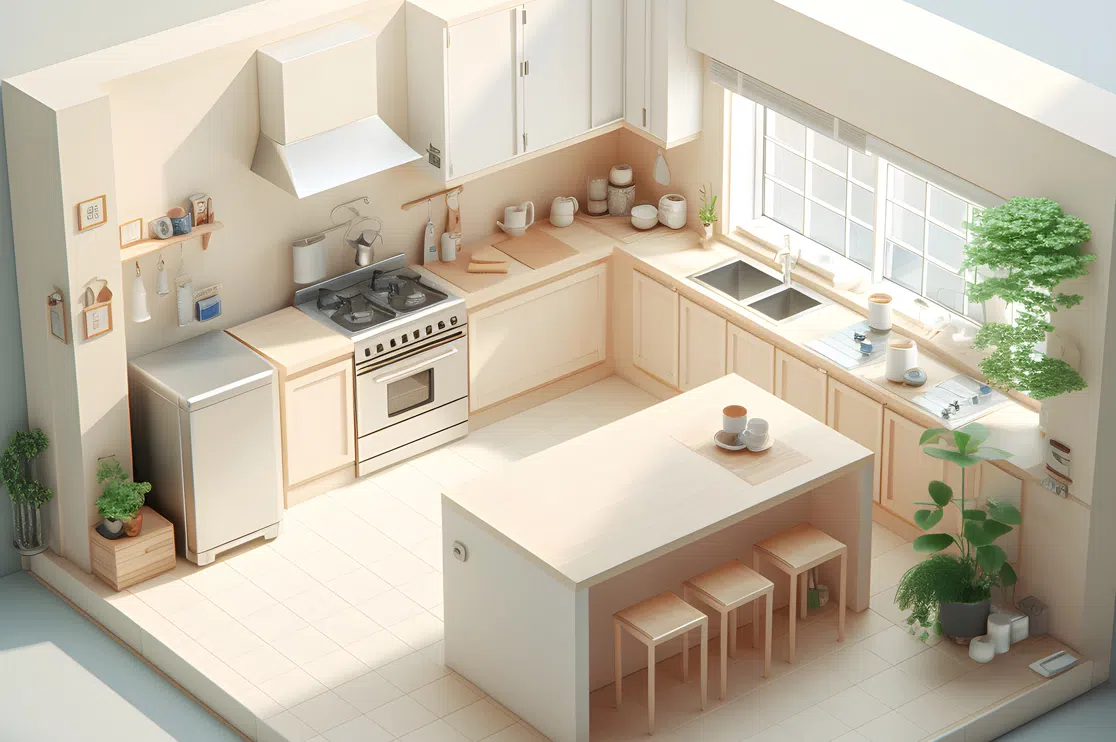In the last few years, luxury, particularly in the home, has shifted away from opulence and towards subtlety and refinement. The focus now finds itself on craftsmanship, high-quality, local materials, and a “less is more” outlook. It is unsurprising, then, that the Japandi style has been gaining popularity.
If you want to incorporate this style, which is modern but warm, it’s important to know its key elements, along with using the right exterior and interior 3D rendering so you know what your space will look like before you’ve laid a single brick.
Table of Contents:
What is the Concept of Japandi Interior Design?
Japandi interior design is a fusion of Japanese and Scandinavian styles, and uses minimalistic designs that are both functional and aesthetically pleasing. You can expect to find muted colors, natural materials, well-curated furniture, and clean lines. Everything about this style is intentional.
The origin of this style sits in murky waters. Some experts say the term was coined by Alyssa Kapito, while others credit the style to Abigail Ahern. Still others point to the design company Katazome.
In a more general sense, the Japandi style dates back to the 18th and 19th centuries, when Scandinavian artists and designers started traveling to Japan, when the country’s closed-border policy was lifted after 220 years. They started to get influenced by housing styles in Japan, and brought their ideas back home. Japanese craftspeople, too, were inspired by Western design styles. Early traces of Japandi style can be seen in architecture, ceramics, and furniture.
If you’ve kept up with interior design trends over the years, you’ve probably come across hygge (pronounced “hoo-guh”) design. This is a Scandinavian concept of coziness and comfort. The Scandinavian and Japanese styles work beautifully together, since both focus on comfort and minimalism.
Even when the two styles diverge, their differences usually only serve to complement one another. For instance, the richer (though still neutral) hues of Japanese style lend warmth to the starker colors of Scandinavian design.
6 Key Elements of Japandi Design
A Decluttered Space
The first key to Japandi interiors is reducing clutter, because the aesthetic focuses on open spaces and clean lines.
However, if you live in an active household and struggle to declutter, you can try using folding screens to hide items, or putting excess stuff in baskets, boxes or built-in storage. This will help your space look less cluttered.
To help maintain tidiness, we recommend modular furniture.
Go for Minimalism
Following from decluttering, minimalism is a crucial ingredient of Japandi interior design.
- Keep only the accessories you need.
- Curate the carefully crafted pieces that will go into your home. Think artwork, carpets, vases, lamps, wall hangings, picture frames, and mirrors. These can make your space feel cosier without making a mess.
- Plants are another fabulous addition. They will soften the minimalist interiors, lend a welcoming air, and are an easy way to bring nature into your home. If you want to lean towards the Japanese influence, you can go for a bonsai.
Craftsmanship & Sustainability
There’s virtually no end to Japandi interior design ideas. Having said that, Japandi furnishings are not meant to be throwaways.
- Opt for pieces that will stand the test of time and complement your space for years to come. Handmade or original pieces work beautifully for this.
- Reclaimed or vintage pieces a great too, following the spirit of sustainability that Japandi follows.
- Don’t be afraid of “imperfections”. They can add character and warmth.
- Choose eco-friendly materials wherever possible.
The Right Materials
Certain materials are almost synonymous with Japandi interior design.
- For furniture, think wood (especially walnut, teak or acorn), bamboo, rattan, cane, wicker and upholstery (such as cotton, flax blends or linen).
- When it comes to textiles, go for organic cotton muslin, organic linen, organic brushed cotton, and velvet.
- Lastly, for décor, choose items made of concrete, terra cotta, wood, clay, glass, or anything handmade with solid colors. Patterns should be kept to a minimum and avoid being loud or bright.
- Don’t be afraid to mix and match styles to create visual interest. For example, in the Japanese style, you’ll find more painted or stained woods, as well as curved furniture, while the Scandinavian style generally focuses on simpler, cleaner lines.
- While light and dark wood are both acceptable, try to match the tone of the wood as much as possible. This helps to create a more harmonious and modern feel.
Neutral Tones
Japandi style favors a neutral color palette. Natural wood tones and muted pastels also work well. Overall, the palette should convey a feeling of calmness and tranquillity.
- Go for colors such as oatmeal, taupe, beige, sand, cream and stone. Avoid anything too bright or white.
- Bold colors should be used minimally, as accents.
- Nothing should be jarring, dominating or grating.
- If you’re finding the abovementioned shades too bland for your tastes, try adding contrasting colors. Richness can be added with darker accents, such as charcoal or black. Softness or playfulness can be included with colors such as pale pink, green, blue or gray.
- Cool metals can be added for visual interest.
Bringing the Outdoors Indoors
Whether it’s a Japandi bedroom or a Japandi kitchen, try to create a space that connects the outdoors with the indoors.
- Think indoor-outdoor living spaces (such as patios or sunrooms), large windows, or greenery and plants (biophilia, anyone?).
- It’s not limited to greenery. To add warmth and coziness, you can use candles or even a fireplace.
- Natural light is another essential part of Japandi interior design. There’s a reason people talk about the right to light. Use large windows to let in sunlight, which can then bounce of bright walls.
- If you feel your Japandi interiors are feeling too cold or too warm, try using different types of lighting to get the look you want.
Conclusion
The Japandi style is perfect for those who want serene and modern, yet warm, interiors. Which parts of Japandi interior design are your favorites? Let us know in the comments!
At BluEntCAD, we understand the frustration of not knowing beforehand if your chosen furnishings will complement each other harmoniously. That’s why we offer photorealistic 3D rendering services, including exterior & interior renders, architectural walkthroughs and fly-throughs, and product modeling.
We serve home builders, real estate developers, interior designers, architects, home renovators, home designers, interior decorators, design build contractors, and remodelers. Browse our portfolio to see how we’ve helped businesses like yours.
Ready to provide the perfect interiors to your clients with architectural renders? Contact us now!







 7 Stunning 3D Kitchen Design Ideas for a Perfect Remodel
7 Stunning 3D Kitchen Design Ideas for a Perfect Remodel  Outdoor Kitchen Designs and Cabinetry for Amenities Beyond Interiors
Outdoor Kitchen Designs and Cabinetry for Amenities Beyond Interiors  Kitchen Cabinet Trends Your Millwork Drafter Must Consider for Remodeling Projects
Kitchen Cabinet Trends Your Millwork Drafter Must Consider for Remodeling Projects  7 Kitchen Cabinet Grades for Remodeling
7 Kitchen Cabinet Grades for Remodeling